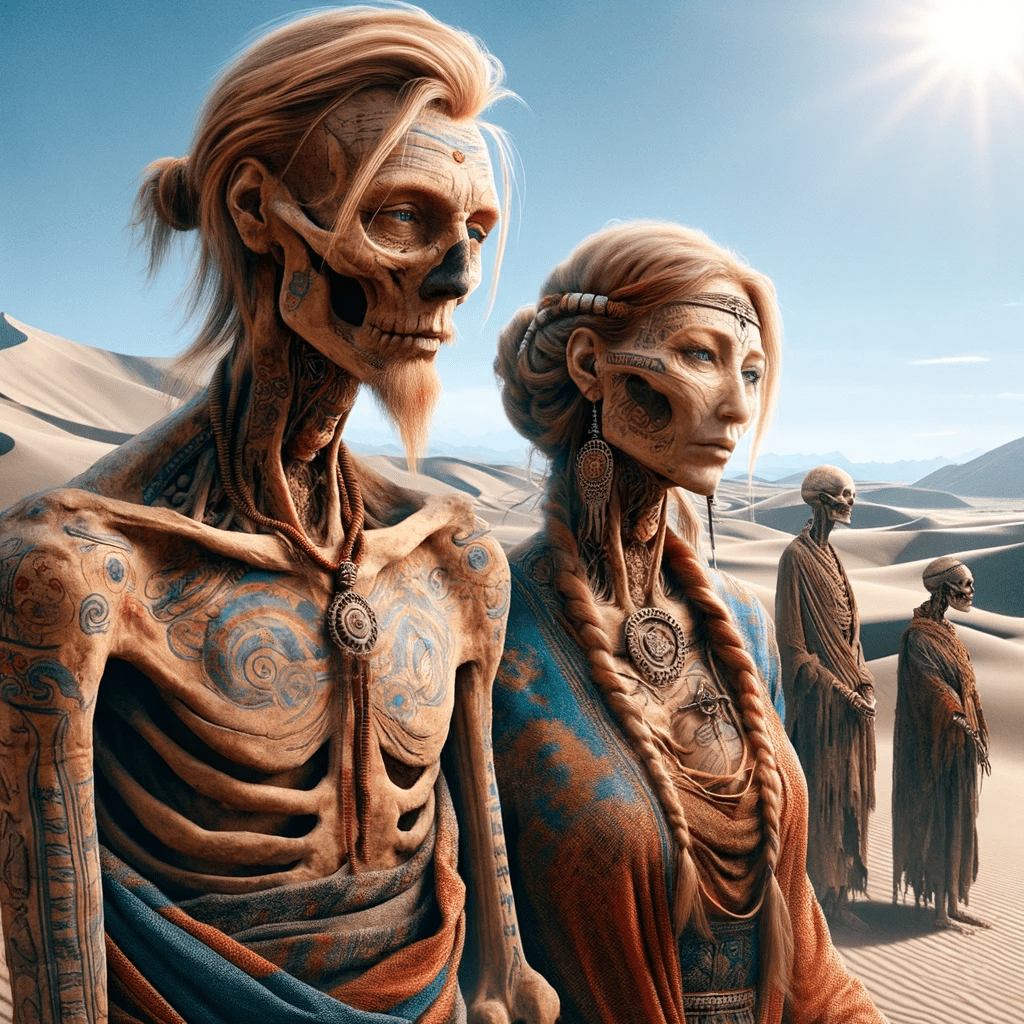Taklamakan Mummies

Nestled in the Tarim Basin of Xinjiang, China, near the expansive Taklamakan Desert, lies a series of discoveries that have transformed our understanding of ancient Eurasian migrations and interactions. These finds, often referred to as the “Taklamakan Mummies” or the “Tarim Mummies,” have been subjects of intrigue, fascination, and controversy since their unearthing.
The Taklamakan mummies are a collection of well-preserved human remains, some dating back to 2000 BC. Unlike the embalmed mummies of ancient Egypt, these bodies were naturally mummified by the arid desert environment. What sets them apart from other ancient discoveries in the region is their Caucasian features. Some of these mummies have long noses, deep-set eyes, and even blonde or red hair, indicating possible Western Eurasian ancestry.
The first of these mummies were discovered in the early 20th century, with further expeditions in the 1980s and 1990s uncovering more. They were found in various burial sites across the Tarim Basin, a region surrounded by mountains that historically acted as a crossroad for the movement of people and ideas, particularly along the Silk Road.
The presence of these seemingly Western-looking mummies in Eastern Central Asia poses essential questions about the early inhabitants of the Tarim Basin, migration patterns, and the cultural exchanges that took place there. It hints at a more intricate and interconnected early history than previously assumed.
DNA studies have played a crucial role in understanding the ancestry of the Tarim mummies. Some genetic research indicates mixed ancestry, with both Western and Eastern genetic markers. This genetic evidence points to the Tarim Basin being a melting pot of sorts for various migrating groups.
- Textile Analysis: Some mummies were found clothed in plaid-patterned textiles resembling Celtic cloths. Dr. Elizabeth Wayland Barber, a professor emerita at Occidental College and an expert on ancient textiles, argues in her work that the weave and pattern are distinctively European. (Source: Barber, E.W., 1999. The Mummies of Ürümchi. W.W. Norton & Company).
- Diverse Burial Practices: The range of burial practices suggests a diversity of beliefs and cultures. For instance, some mummies were buried in boats, even though there were no significant bodies of water nearby. This discovery was documented in Victor Mair’s research from the University of Pennsylvania. (Source: Mair, V.H., 2006. The Mummies of East Central Asia. Expedition magazine, 48(3), pp.15-21).
- Tattooed Mummies: Some of these mummies have intricate tattoos. The designs, as documented by Chinese archaeologist Jia Peter Weiming, resemble motifs found in other ancient cultures, further emphasizing cultural exchange. (Source: Jia, P.W. and Betts, A., 2010. A re-analysis of the Qäwrighul and Xiaohe Cemetery finds. Journal of Indo-European Studies, 38(3&4), pp.275-317).
Various scholars have weighed in on the mummies. Dr. Victor Mair, a professor at the University of Pennsylvania, has been one of the most prominent voices, emphasizing their significance for understanding Eurasian history. He believes these mummies offer a rare glimpse into ancient cultures that may have otherwise been lost to history.
In The Mummies of Ürümchi by Dr. Elizabeth Wayland Barber, she looks into the textiles found with the mummies, positing European connections. Another seminal work, The Tarim Mummies: Ancient China and the Mystery of the Earliest Peoples from the West by J.P. Mallory and Victor Mair, further discusses the mummies’ origin and their potential connection to Indo-European migrations.
Some online forums and publications have asserted that these mummies might be lost European civilizations or even extraterrestrial beings.
The Taklamakan Mummies present a captivating chapter in the annals of archaeology. They challenge previous historical narratives, propose new ones, and underline the ancient human migrations and interactions.


